GP53
| Location: Bass | Property: Hart |
| Aust. Soil Class.: Endohypersodic, Epipedal, Black VERTOSOL | |
| General Landscape Description: Level plain (0-1% slope) within the Bass River Plain (back swamp). Original vegetation included Melaleuca sp. | |
| Geology: Quaternary swamp deposits | |
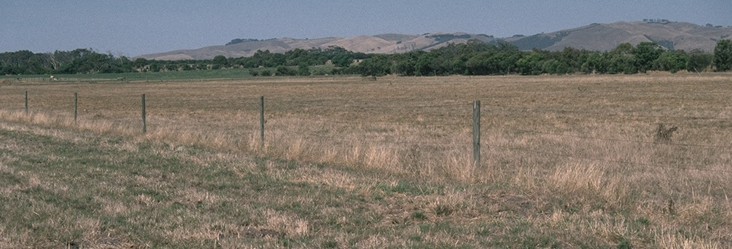
GP53 Landscape
Soil Profile Morphology:
Surface Soil
| A1 | 0-25 cm | Very dark greyish brown (10YR3/2); medium clay; hardsetting surface condition parting to self mulching; moderate coarse polyhedral, parting to strong fine polyhedral structure; strong consistence dry; pH 5.5; clear to abrupt change to: | 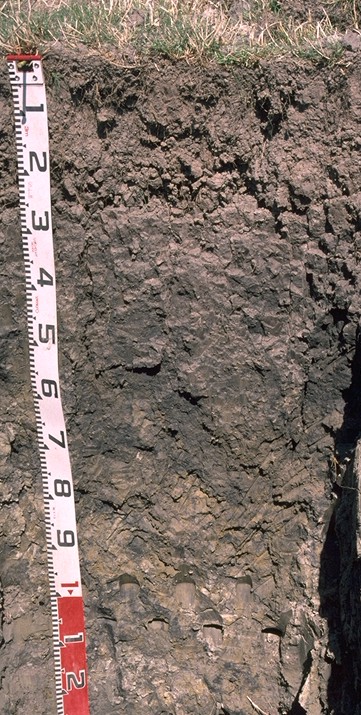 GP53 Profile |
| Subsoil | |||
| B21 | 25-70 cm | Very dark grey (10YR3/1) with brownish yellow (10YR6/8) mottles at depth; heavy clay; moderate coarse prismatic, parting to strong coarse blocky structure; strong consistence dry; pH 6.3; gradual change to: | |
| B22 | 70-120 cm | Grey (10YR5/1) with brownish yellow (10YR6/8) and very dark grey (10YR3/1) mottles; medium heavy clay; moderate coarse prismatic, parting to moderate coarse blocky structure; pH 7.2: | |
| B23 | 120+ cm | Grey (10YR5/1) with yellow (10YR7/6) mottles; moderate lenticular structure; pH 7.8. | |
Key Profile Features:
- Hardsetting surface condition breaking down to self-mulching.???Mark??
- Vertic properties present within the subsoil.
pH | Salinity Rating | |||
Surface (A1 horizon) | Strongly Acid | Low | Non-Sodic | None |
Subsoil (B21 horizon) | Slightly Acid | Very Low | Sodic | None1 |
Deeper subsoil (at 1 m) | Slightly Alkaline | Moderate | Sodic | None |
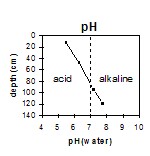 The surface soil is strongly acid. The upper sub-soil is slightly acid becoming slightly alkaline at depth. | 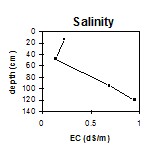 The salinity rating in the surface soil is low. The upper subsoil is very low becoming moderate at depth. | 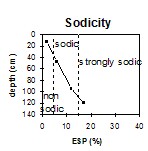 The surface soil is non-sodic. The subsoil is sodic. | 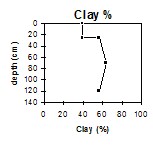 The clay content increases abruptly at the A/B boundary. |
Horizon | Horizon Depth | pH (water) | pH CaCl2 | EC 1:5 | NaCl | Exchangeable Cations | |||
Ca | Mg | K | Na | ||||||
Meq/100g | |||||||||
A1 | 0-25 | 5.5 | 5 | 0.23 | 13 | 5.4 | 0.66 | 0.58 | |
B21 | 25-70 | 6.3 | 5.4 | 0.14 | 11 | 11 | 0.47 | 2 | |
B22 | 70-120 | 7.2 | 6.7 | 0.69 | 0.13 | 11 | 12 | 0.2 | 4 |
B23 | 120+ | 7.8 | 7.3 | 0.95 | 0.17 | 9.6 | 9.8 | 0.2 | 4.5 |
Horizon | Horizon Depth | Ex Al mg/kg | Ex Ac meq/100g | Wilting Point pF4.2 g/100g | Coarse Sand (0.2-2.0mm) % | Fine Sand (0.02-0.2mm) % | Silt (0.002-0.02mm) % | Clay (<0.002mm) % |
A1 | 0-25 | <10 | 15 | 29.8 | 1 | 10 | 37 | 39 |
B21 | 25-70 | <10 | 8.4 | 22.4 | 1 | 5 | 33 | 57 |
B22 | 70-120 | <10 | 5.2 | 23.2 | 1 | 4 | 28 | 64 |
B23 | 120+ | <10 | 3 | 20.1 | 1 | 6 | 33 | 57 |
Management Considerations:
Surface (A) Horizon
- The surface soil (A1) is strongly acid. As a result, deficiencies in molybdenum, potassium and phosphorus may occur. Manganese toxicity may also occur in strongly acid soils, particularly when poorly drained (as waterlogging may bring manganese into solution).
- The inherent fertility of the surface (A1) horizon (based on the sum of the exchangeable calcium, magnesium and potassium cations) is high. The nitrogen levels are also high.
- The high wilting point value (i.e. 30%) indicates that plants will be unable to utilise light rains when the soil is relatively dry.
- The dense and coarsely structured upper subsoil (B21) horizon is sodic, however, strong dispersion only occurs after remoulding. The deeper subsoil becomes strongly sodic at 105 cm. The subsoil is dense and coarsely structured which will restrict root movement down the profile.
- The subsoil has vertic properties which indicates that significant shrinking and swelling occurs during wetting-drying cycles. This can disrupt the roots of perennial plants and may have implications for engineering applications (eg. building foundations and fence lines).
- The presence of mottling throughout the subsoil indicates that the profile is seasonally waterlogged.
- The level of soluble salts increases with depth and the salinity rating is moderate in the deeper subsoil (ie. from 1 m depth). This is only likely to restrict the growth of deeper rooted salt sensitive species.


